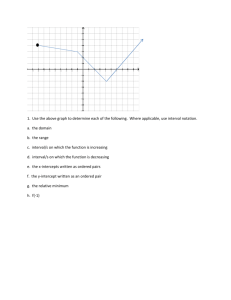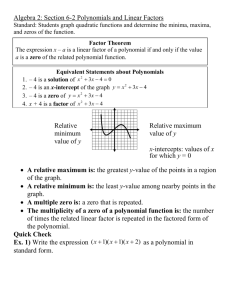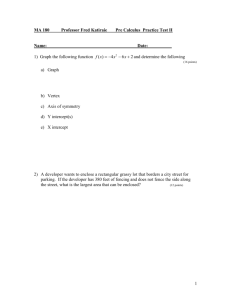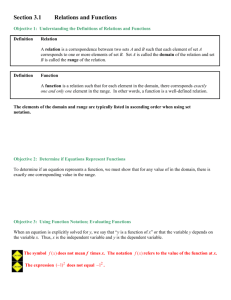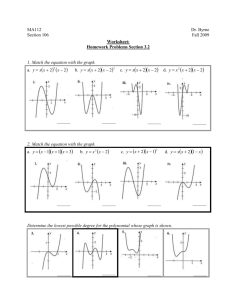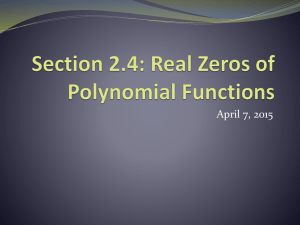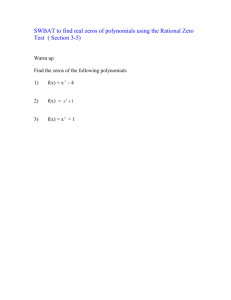POLYNOMIAL FUNCTIONS (CH
advertisement
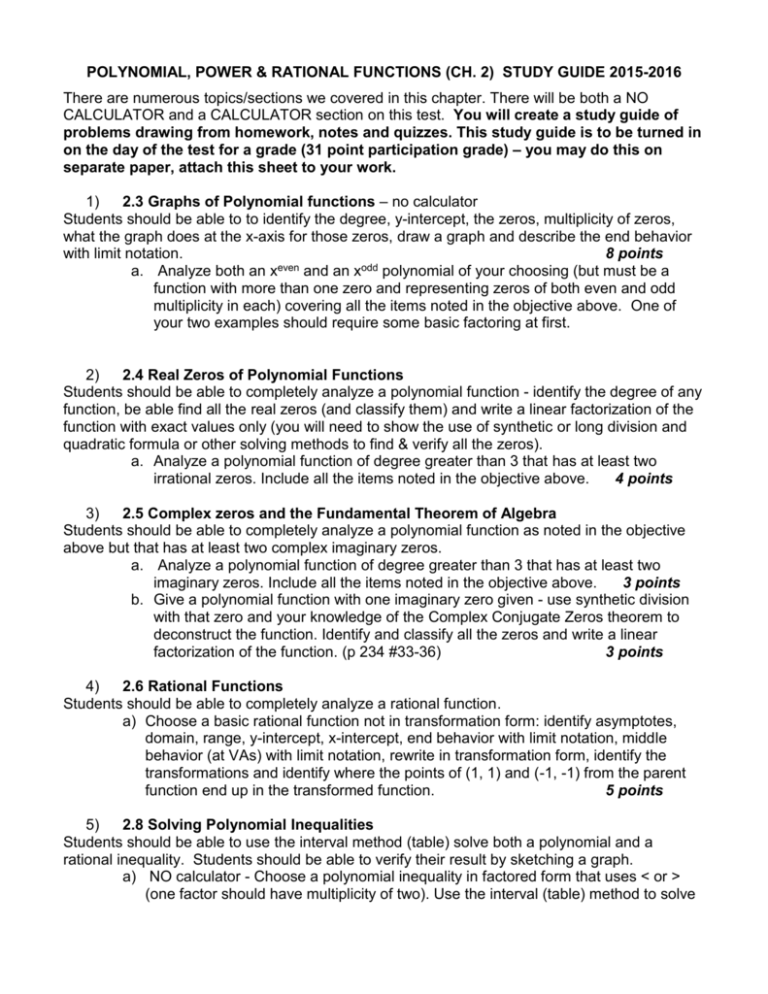
POLYNOMIAL, POWER & RATIONAL FUNCTIONS (CH. 2) STUDY GUIDE 2015-2016 There are numerous topics/sections we covered in this chapter. There will be both a NO CALCULATOR and a CALCULATOR section on this test. You will create a study guide of problems drawing from homework, notes and quizzes. This study guide is to be turned in on the day of the test for a grade (31 point participation grade) – you may do this on separate paper, attach this sheet to your work. 1) 2.3 Graphs of Polynomial functions – no calculator Students should be able to to identify the degree, y-intercept, the zeros, multiplicity of zeros, what the graph does at the x-axis for those zeros, draw a graph and describe the end behavior with limit notation. 8 points even odd a. Analyze both an x and an x polynomial of your choosing (but must be a function with more than one zero and representing zeros of both even and odd multiplicity in each) covering all the items noted in the objective above. One of your two examples should require some basic factoring at first. 2) 2.4 Real Zeros of Polynomial Functions Students should be able to completely analyze a polynomial function - identify the degree of any function, be able find all the real zeros (and classify them) and write a linear factorization of the function with exact values only (you will need to show the use of synthetic or long division and quadratic formula or other solving methods to find & verify all the zeros). a. Analyze a polynomial function of degree greater than 3 that has at least two irrational zeros. Include all the items noted in the objective above. 4 points 3) 2.5 Complex zeros and the Fundamental Theorem of Algebra Students should be able to completely analyze a polynomial function as noted in the objective above but that has at least two complex imaginary zeros. a. Analyze a polynomial function of degree greater than 3 that has at least two imaginary zeros. Include all the items noted in the objective above. 3 points b. Give a polynomial function with one imaginary zero given - use synthetic division with that zero and your knowledge of the Complex Conjugate Zeros theorem to deconstruct the function. Identify and classify all the zeros and write a linear factorization of the function. (p 234 #33-36) 3 points 4) 2.6 Rational Functions Students should be able to completely analyze a rational function. a) Choose a basic rational function not in transformation form: identify asymptotes, domain, range, y-intercept, x-intercept, end behavior with limit notation, middle behavior (at VAs) with limit notation, rewrite in transformation form, identify the transformations and identify where the points of (1, 1) and (-1, -1) from the parent function end up in the transformed function. 5 points 5) 2.8 Solving Polynomial Inequalities Students should be able to use the interval method (table) solve both a polynomial and a rational inequality. Students should be able to verify their result by sketching a graph. a) NO calculator - Choose a polynomial inequality in factored form that uses < or > (one factor should have multiplicity of two). Use the interval (table) method to solve the inequality. Write the solution in interval form. Draw a graph to verify that your result is correct. 4 points b) Calculator OK - Choose a rational inequality that uses < or >. . Use the interval (table) method to solve the inequality. Write the solution in interval form. Draw a graph to verify that your result is correct. It is recommended that your example has sum or difference that must be combined (see page 265 # 49, 50) 4 points The test contains problems like the ones above but is not limited to just those types. Be sure you review your class notes and homework. Optional review problems pp 269 – 272 just some extra practice! #s 17, 19, 45-49, 53, 55, 56, 61, 64, 67, 69, 91 – check odd answers in back of book. Evens 46) d 48) a 56) 3 i , 1 2i f(x) = (x – 1 – 2i)(x – 1 + 2i)(x – 3 – i)(x – 3 + i) 64) f(x) = (x – 1 – i)(x – 1 + i)(x – 2) = x3 – 4x2 + 6x – 4

